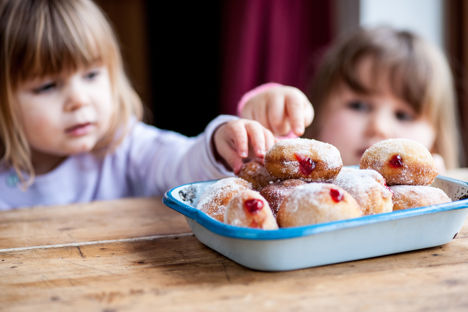
How to involve your children in cooking
Children like to help. They want to learn. And they love to copy adults. To a cautious parent, the kitchen is a room full of hot pan hazards and potential finger cuts. But to children, it’s a fascinating, creative, even magical place.
How to involve your children in cooking
Children like to help. They want to learn. And they love to copy adults. To a cautious parent, the kitchen is a room full of hot pan hazards and potential finger cuts. But to children, it’s a fascinating, creative, even magical place.
Children like to help. They want to learn. And they love to copy adults. To a cautious parent, the kitchen is a room full of hot pan hazards and potential finger cuts. But to children, it’s a fascinating, creative, even magical place.
It’s never too early to encourage children to develop a positive relationship with the kitchen. Don’t wait for them to ask – show them. You’ll be able to teach them valuable skills, a sense of responsibility, and have fun together. If you’re already an enthusiastic cook, children will associate the preparation of food as a good thing. If you’re not, take the time to learn together. Kids will need to be supervised at all times but as most primary caregivers spend hours in the kitchen, this isn’t hard.
Start your toddler on simple yet worthwhile tasks such as taking food peelings to the bin or recycling packaging. Remove sharp objects then let them pass you plates from the dishwasher. If there’s a spill, ask them to mop it up. Give them food or containers from the fridge to carry over to the worktops. Little tasks like these give your child purpose, and, for preschoolers at least, they’re actually exciting!
In the supermarket, play a game of Fetch! Ask the kids to gather produce from low shelves. The more involved they are the greater the diversion from tantrums. Another tip – feed them before you go to the shops to prevent them from screaming for treats.
Back home, let kids help you put food away so they learn what goes in the fridge, freezer and cupboards. Teach provenance: potatoes come from the ground; eggs come from chickens; beef comes from cows, chocolate is made from cocoa beans, and so on. Respond to their questions – if you don’t know, look it up together.
Keep food neutral. Even if you’d kill for a cupcake, cook healthy meals as well. Have a break from bolognese and macaroni cheese and prepare foods such as dhal, falafels or chicken tikka masala.
Don’t forget to:
1. Teach good hygiene: make washing hands and wearing an apron part of the process.
2. Accept the mess: it’s inevitable.
3. Teach tidying up: professional chefs always have clean workstations.
4. Be patient: you were young once.
5. Find the time: overworked parents often find this the hardest part, but as you have to cook for your family regardless, let your children benefit.
If your child is under five years old, keep it short; you’ll have around 10-15 minutes before their attention wanders. A failsafe option is to choose no-cook recipes such as hummus, chocolate cornflake cakes and fruit salad. A small, slip-free chair or step is a good idea so they can reach the worktops.
Toddlers can help to:
1. Mix ingredients together.
2. Combine ingredients with a spoon.
3. Toss or spin salads.
4. Pour, stir or sprinkle.
5. Hand you items and wipe utensils and bowls before use.
6. Tidy up: even if it’s not up to your standards every little helps.
When your child is old enough to listen to more detailed instructions, you can take it up a notch. If you grow your own, ask them to pick herbs or vegetables. Alternatively, show how to grow cress in eggcups so they can nurture a living plant. It’s also a good age to start teaching food safety.
Preschoolers can perform toddlers’ tasks and also help to:
1. Rinse and scrub vegetables.
2. Mash ingredients.
3. Use a knife to spread butter.
4. Top and tail beans and remove stems off fruit.
5. Roll out dough.
Five year olds can:
1. Use a hand-held juice squeezer, grater and garlic crusher.
2. Count and measure ingredients.
3. Prepare sandwiches.
4. Knead dough.
5. Spoon mixture into cases for baking.
6. Lay the table.
Teenagers will feel an enormous sense of accomplishment from preparing a whole meal. Guide them by browsing cookbooks or online recipe sites and helping them to write a timeplan.
Older children can:
1. Crack, whisk, fry and poach eggs.
2. Dice, julienne and sauté vegetables.
3. Marinate and sear meat.
4. Use a cooker and hob.
5. Plan and cook a three-course meal.

